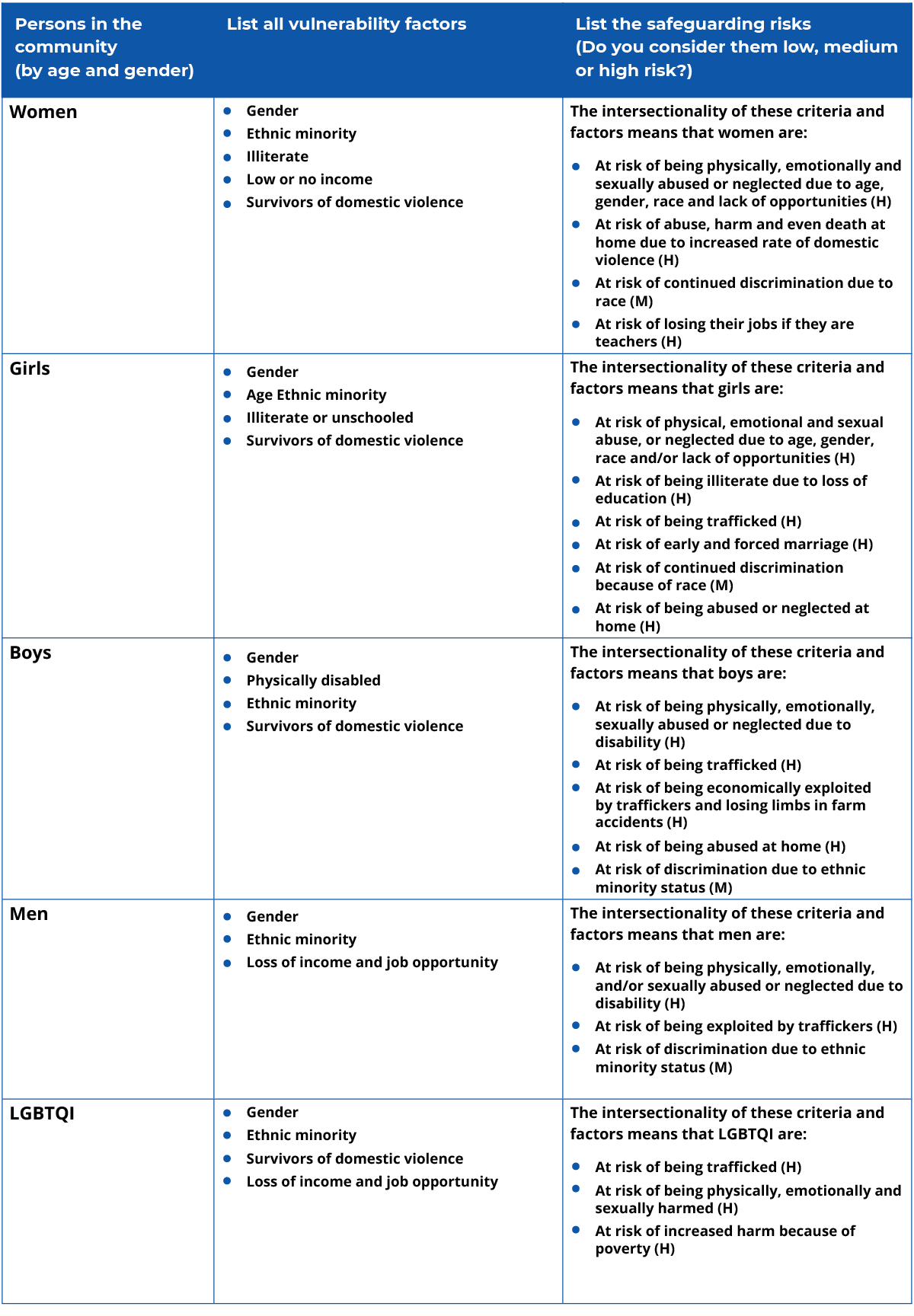Unit 2: Identification
2.4 Assessing risk; conducting a situational analysis.
We have covered a number of different factors that affect ‘risk’ and how it is perceived. Here we discuss the methodologies that can be used to effectively conduct a formal assessment of these risks.

Staying with the case study of ABC University, undertaking a ‘situational analysis’ can help to understand the context that the research team will be working in.
We already know that the external factors of drought and displacement have made all community members vulnerable. Using this as a backdrop, we then take a gendered approach to highlight specific vulnerabilities.
|
Activity 2.6 Situational analysis template Allow 30 minutes Complete the blank situational analysis template for the case study of ABC University. Here is a writable version of this situational analysis template shown below. You can type into this PDF form and then save it and/or print it.
An example of a completed situational analysis is shown below for comparison. Situational analysis – context: A displaced community due to drought
Here is a PDF version of this model situational analysis shown above. You can learn more about undertaking a situational analysis by following the link below:
|
Risk Assessments
We should also develop a safeguarding risk assessment based on the situational analysis. You may remember that we learnt about such risk assessments in Course 1: Introduction to Safeguarding in the International Aid Sector.
Still using the example of the ABC University research case study, let’s go through three quiz questions so that you can try and recall how to undertake a safeguarding risk assessment exercise.
|
Activity 2.7 Identifying risks (Quiz) Quiz rules Quizzes within the learning content do not count towards achieving your Digital Badge/Statement of Participation. Only the quiz at the end of each unit counts towards achieving your Statement of Participation. You may take as many attempts as you wish to answer the quiz. You can skip questions and come back to them later if you wish. |
How to undertake a risk assessment
![]()
As a reminder on how to undertake a safeguarding risk assessment watch the video above.
Developing a risk assessment

© Panuwat Dangsungnoen / iStock / Getty Images Plus
When undertaking a risk assessment for the research project being conducted by ABC University, here are some key points to think about:
- A risk assessment should be carried out with input from local collaborative partners and community members so that external risks and vulnerabilities are also taken into consideration.
- A risk assessment must identify and record all risks of intended or unintended harm. It should not only consider risks to research participants, but also risks to researchers.
- Mitigation safeguarding measures should be proposed and put in place.
- A risk analysis must differentiate between short-term risks (for example, immediate dangers that could arise during the fieldwork) and long-term risks (for example, participants’ future eligibility to access benefits when a programme is implemented).
- A risk analysis should include considerations on how to ensure participants’ confidentiality for safety or legal reasons and put in place a protocol for this.
- The names and contact details of both the research team and the safeguarding focal points should be clearly stated in the risk analysis.
- The risk analysis should be signed off by team leaders and the Safeguarding Lead.
A risk assessment should be continuously updated throughout the course of a research project. If it emerges that the research carries a higher risk for any one group or person than was initially thought, then it should be redesigned to address and reduce those risks. If this is not possible, the research cannot go ahead.
|
Activity 2.8 Developing mitigating safeguarding measures Return to the case study of ABC University and reflect on the following:
|
If you want to learn more about risk assessment have a look at the following links:
- Safeguarding risk assessment and management tool (PDF) Safeguarding Resource and Support Hub
- Research Ethics: A practical guide Oxfam GB
- Addressing Safeguarding Risks Safeguarding Resource & Support Hub

